Porsche 914 History & Story
Porsche needed an entry-level car to replace the 912 and Volkswagen needed a sports car to replace its Karmann Ghia, so the forces were joined to build a sports car that would be an affordable Porsche and a modern Volkswagen. Given the type 914 designation, the design process of the roadster started in 1966 and the full size clay model was made in 1967. The design group was led by Heinrich Klie and Ferdinand Alexander Porsche. Ferdinand Piëch, as the head of development at Porsche, was also the 914 project leader. On March 1, 1968, the first 914/4 prototype was driven. The car had the flat-4 engine mounted in front of the rear axle. The mid-engine layout meant the 914 could achieve higher cornering G-forces than the 911.
As a project leader, Ferdinand Piëch had his technicians fit one of the prototypes with the 3-litre flat-8 fuel injected 16 spark plug engine from the Porsche 908 racing car.
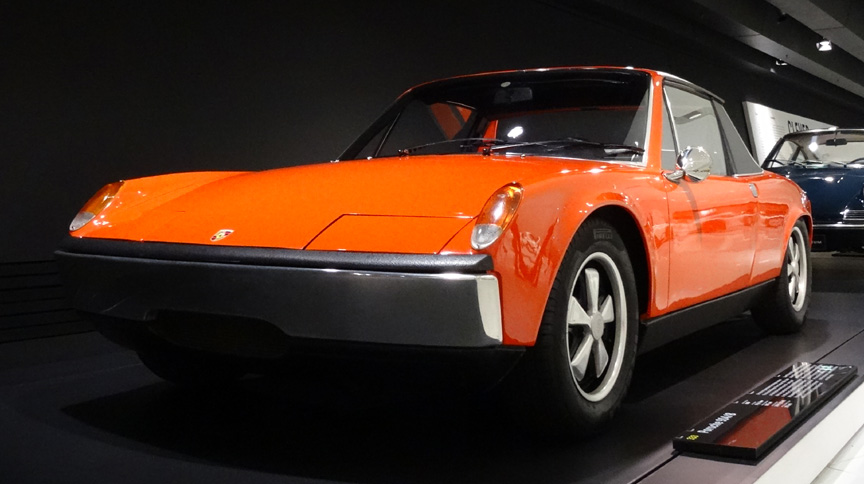
Agreed in January 1969, the marketing company VW-Porsche Vertriebsgesellschaft mbH was founded in April. Both parties had a 50% share. From now on, the sales operations for the 911, 914-4 and 914-6 were carried out by the marketing company. Key positions were held on an equal authority basis by Otto-Erich Filius of Porsche (formerly Vice-President Porsche of America) and Klaus Schneider of VW. Naturally, the establishment of the joint venture started the rumours of the merger of VW and Porsche. Porsche even had to emit a special press release to convince that Porsche and Volkswagen are independent companies.
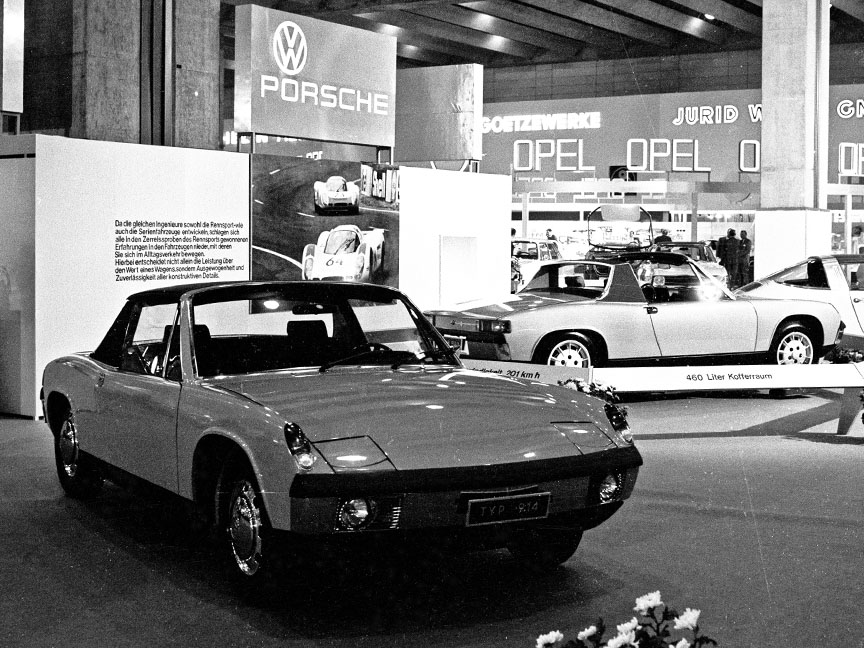
Introduced on September 11, 1969 in Frankfurt, the 914 could be seen both on the VW-Porsche exhibition stand and on the Karmann stand. As agreed, the 914 will be sold in Europe as a VW-Porsche and in the USA as a Porsche. The 914/4 was equipped with the 1.7L 4-cylinder Volkswagen 411E engine with Bosch electronic fuel injection and the car was fully produced at the Karmann plant in Osnabrück. The 914/6 had its body made at Karmann and then shipped to Stuttgart for the marriage with the 1969 model year 911 T 6-cylinder 2-litre carburetor engine (911s already had 2.2-litre engines at the time). Despite the Porsche body and the Porsche engine, the European 914/6 was called the VW-Porsche according to the agreement. The wheels, hubs and brakes for the 914/4 came from the VW 411 family car and for the 914/6 from the 911. The production of the 914/4 started in 1969 (as model year 1970) and the production of the 914/6 in 1970.
The front and rear sections of the body are formed as easily deformable crumple zones. The passenger compartment is a deformation-rigid safety cell. The safety steering column provides the driver with better protection. Saving the cost, the passenger seat was not adjustable (until the end of model year 1971). On some markets the optional central seat cushion and seat belt for a child were available, making it a 3-seater. The hand brake lever was placed to the left of the driver. Despite the Porsche’s entry-level model wasn’t a 4-seater anymore and despite its performance figures not better than of the outgoing 912, in cooperation with Volkswagen the car is priced so well that it becomes Porsche’s best seller.
Porsche was really concerned about its image now when the 914 was made in cooperation with Volkswagen and stressed on journalists in the August 25, 1969, press release that the car should not be called as “Volksporsche” (“People’s Porsche”), nor ‘VOPO’ (called as the “fatal synonym” in this press release). The press release marks the 914 1.7 to cost 12.000 DM and the 911 2.2 S 30.000 DM, so a 2.5 times difference between the entry-level and the top-of-the-line Porsche.
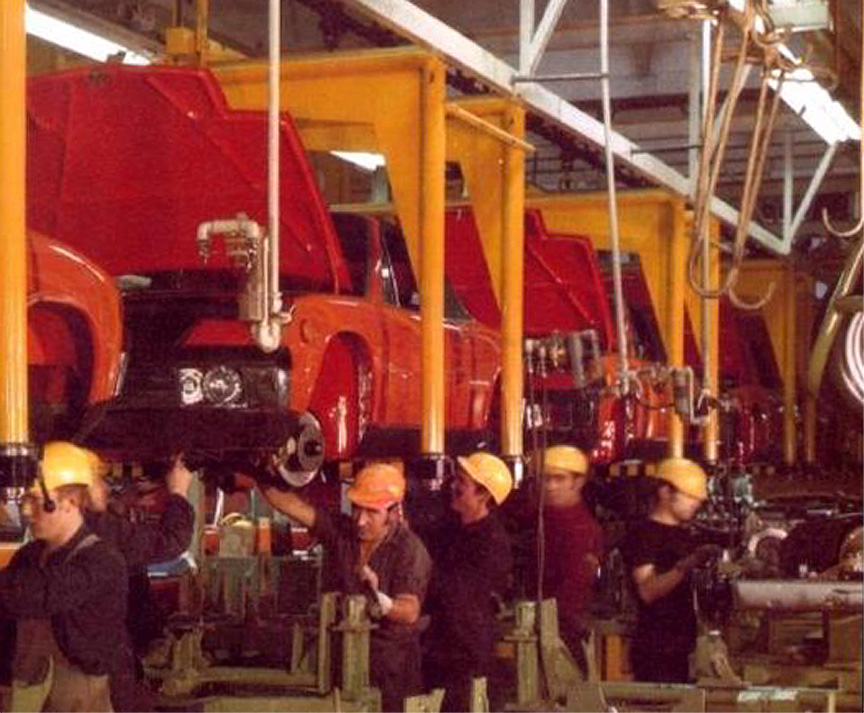
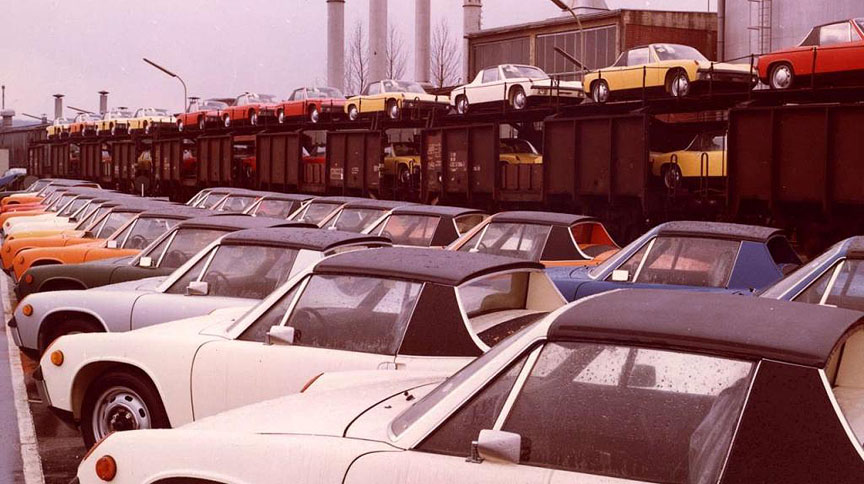
The 914/4 was available with 15″ VW steel wheels (first design MY1970-73 with chrome hub caps, second design MY1974-76), 15″ Pedrini wheels, 15″ Mahle wheels and 15″ 4-bolt Fuchs wheels. The 914/6 was available with 15″ steel wheels (silver or chrome), 15″ Mahle wheels and with 15″ Fuchs wheels. In addition the 14″ Fuchs wheels could be ordered for more comfortable ride (higher tyre profile).
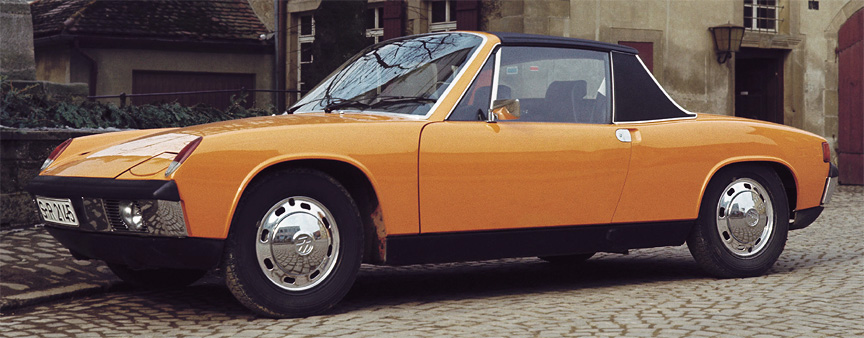
The 914 has the luggage compartments in the front and at the back, with total volume comparable to a mid-size family car. The removable fiberglass roof panel could be stored in the rear trunk.
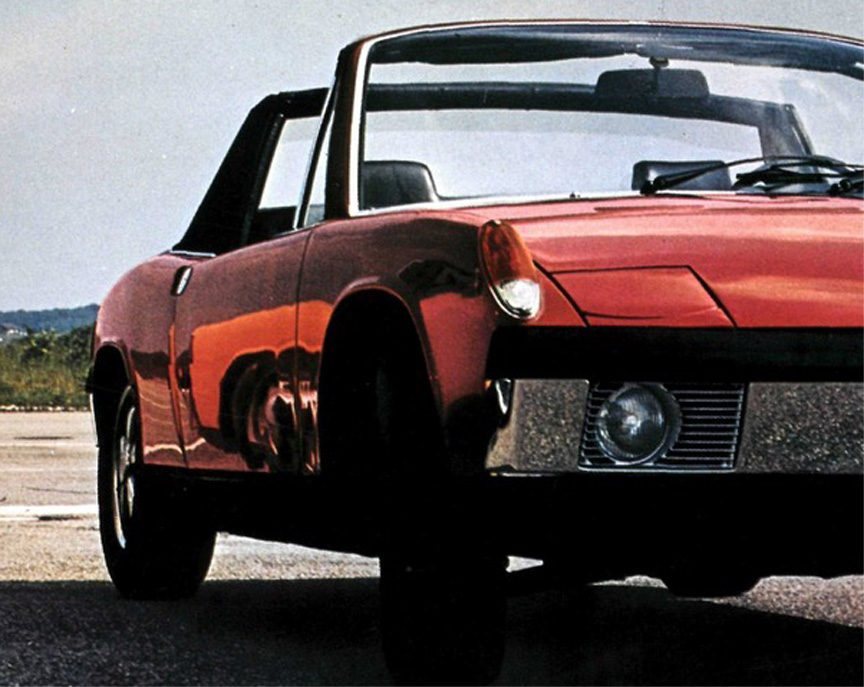
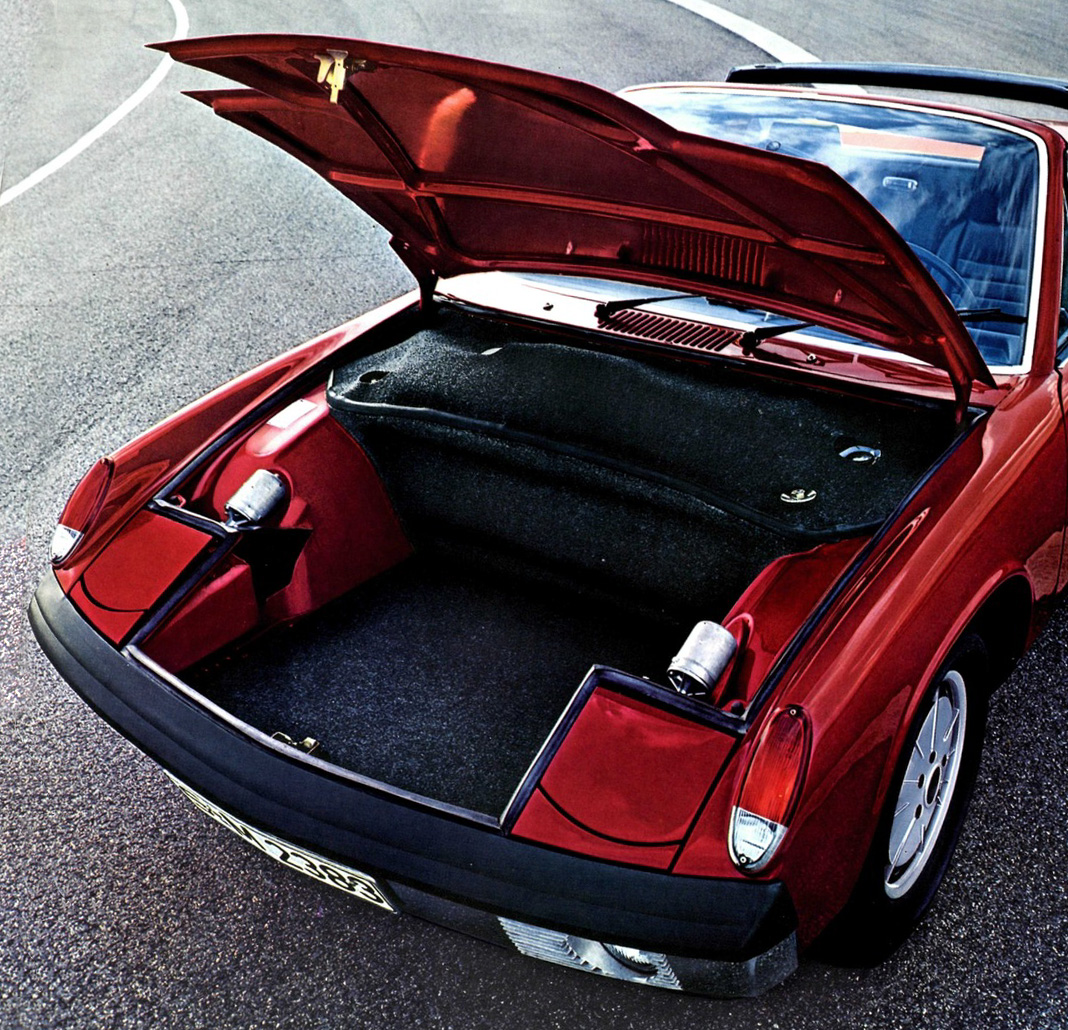
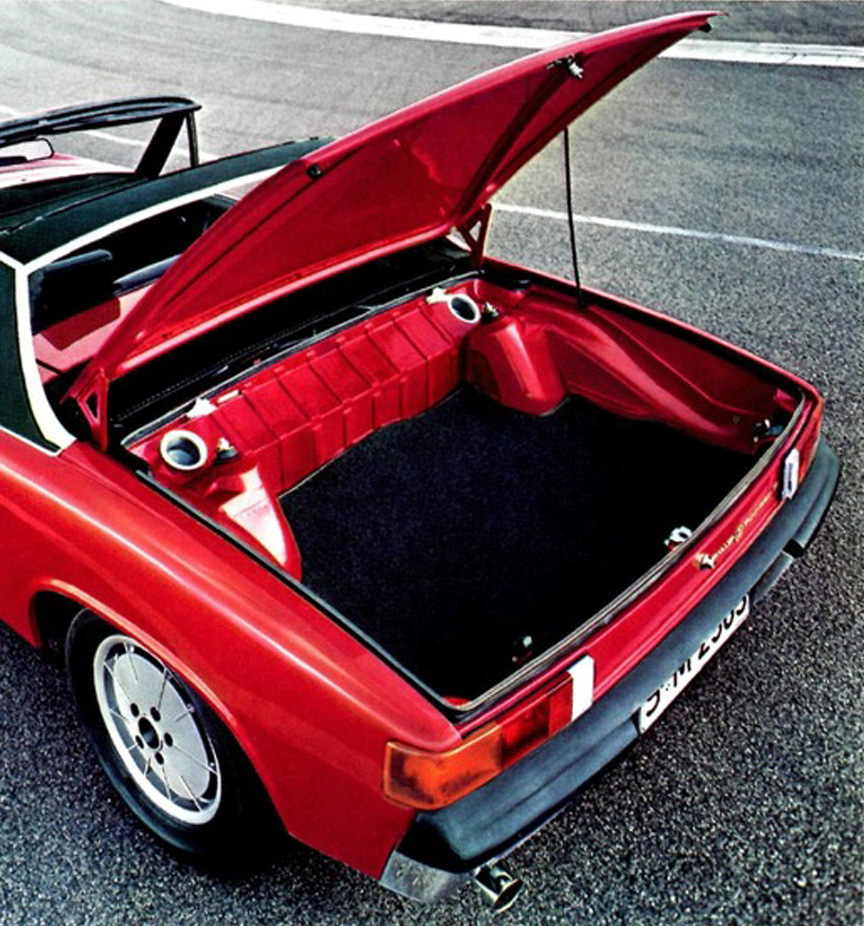
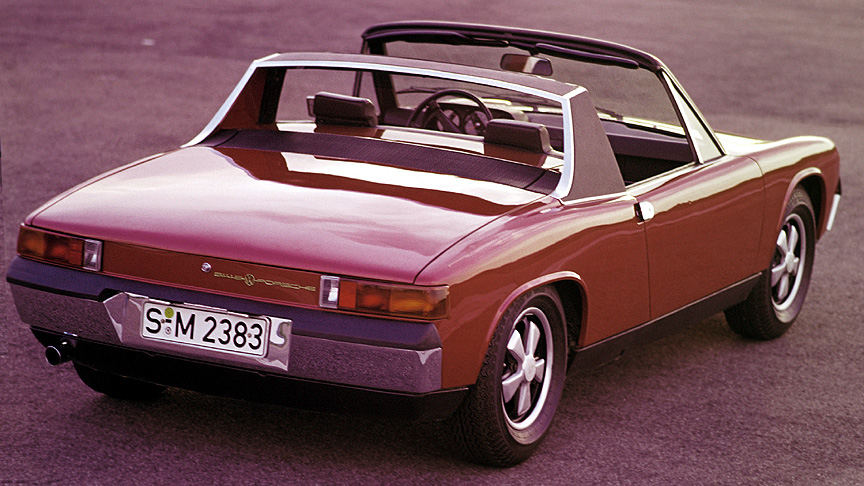
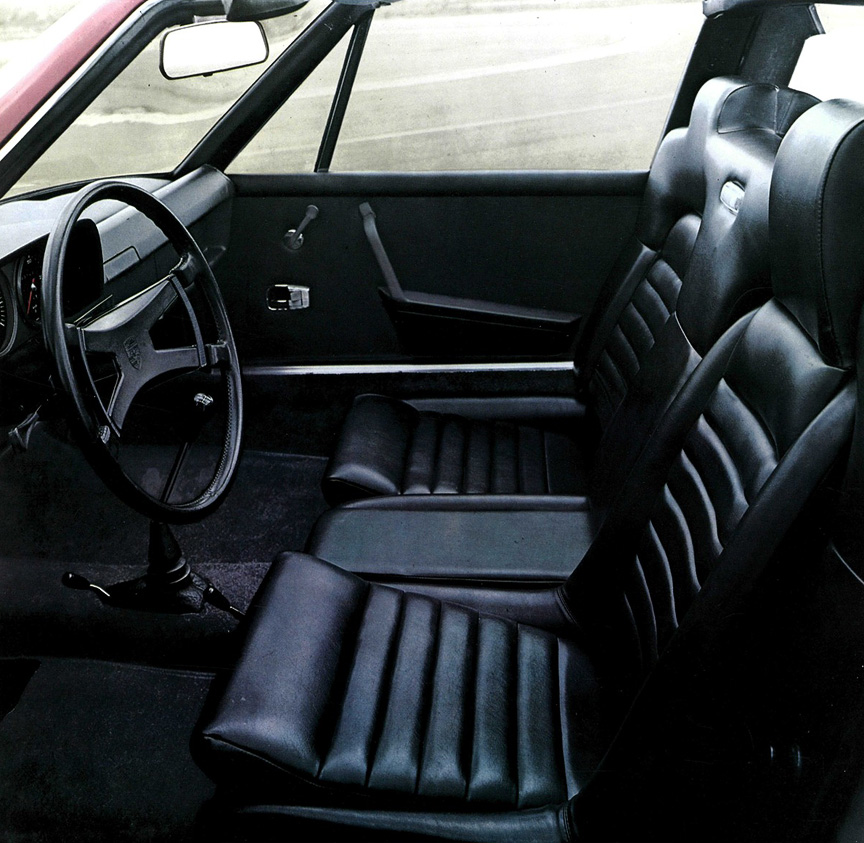
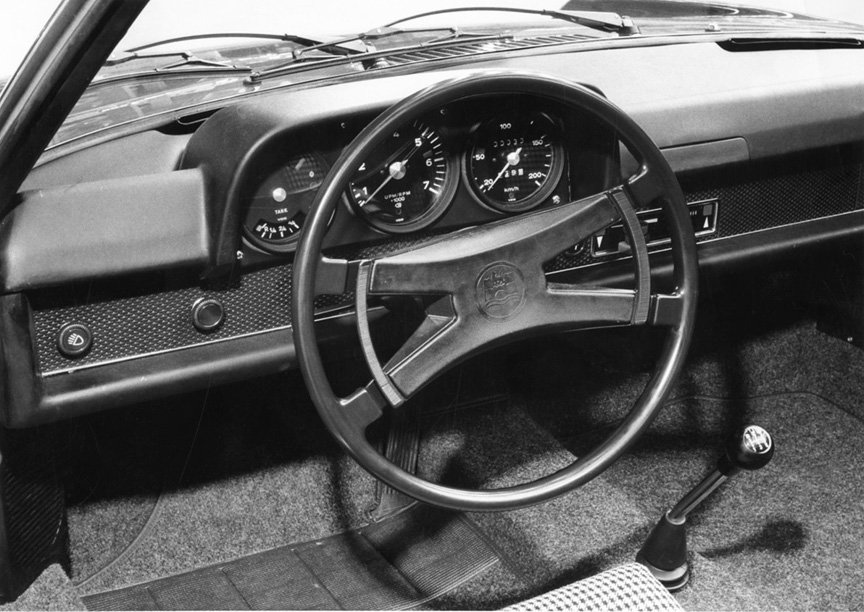
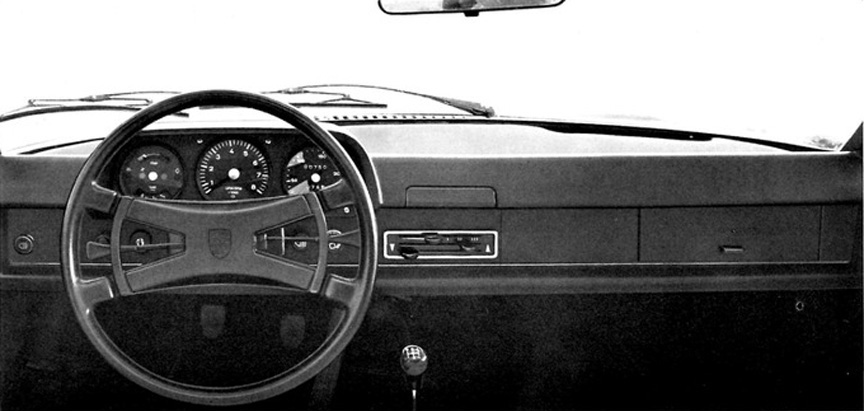
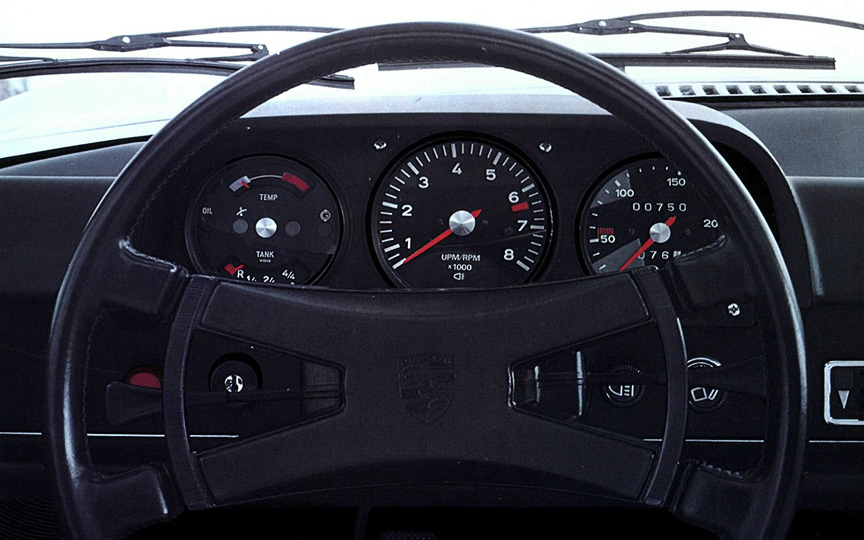
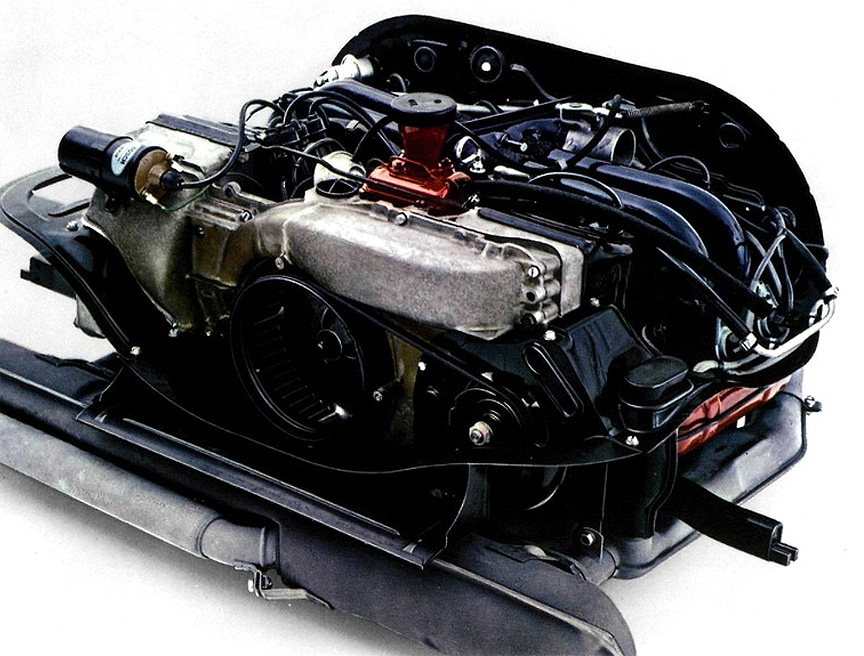
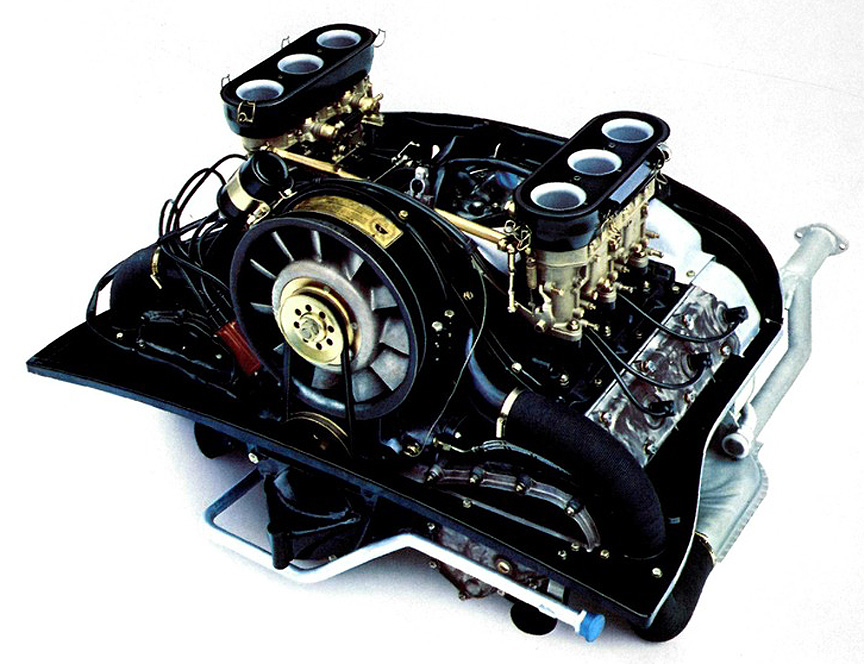
All the 914s were equipped with the 5-speed gearbox as standard and the 914/6 was also available with the 4-speed Sportomatic. Sportomatic was a mechanical gearbox with hydraulic gearchange. There was no clutch pedal – moving the gear lever initiated the hydraulic actuation of the gear change. Instead of the clutch there was a torque converter.
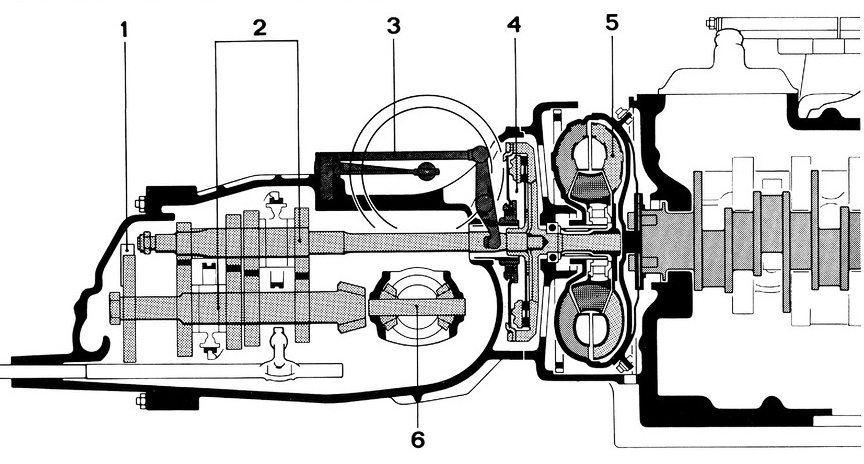
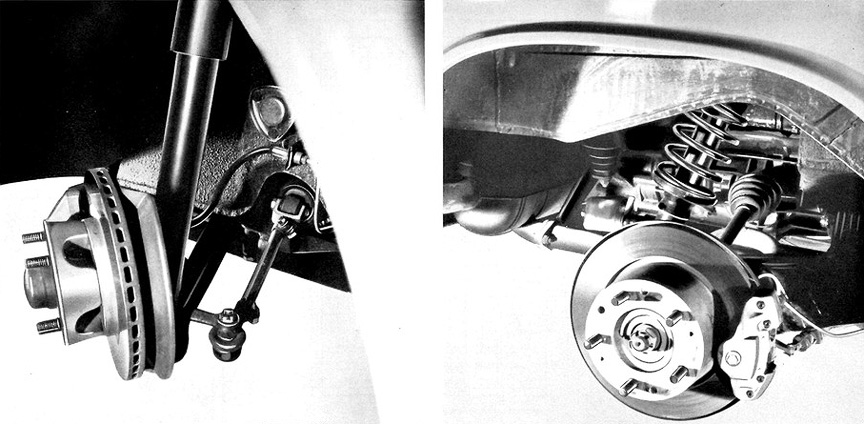
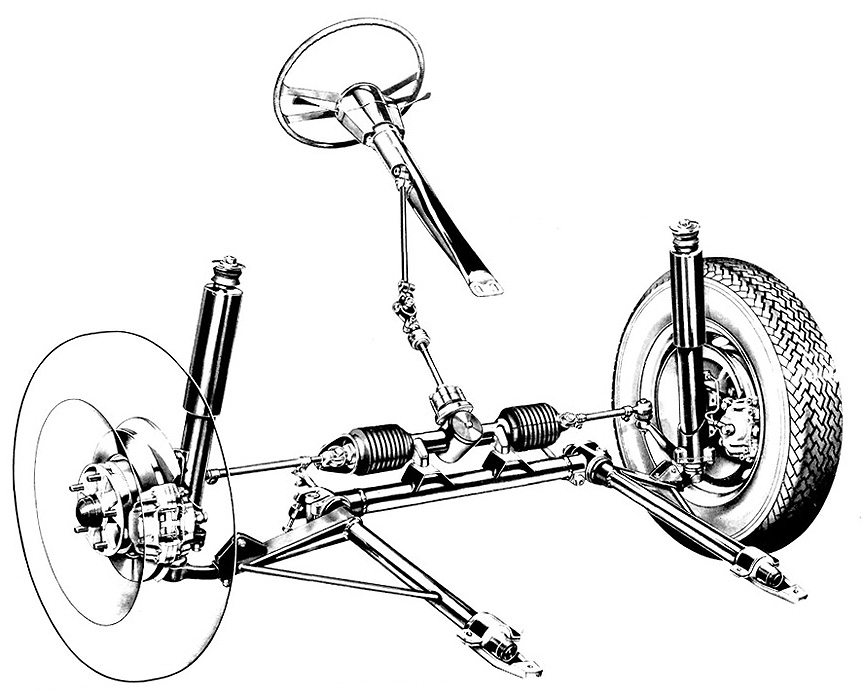
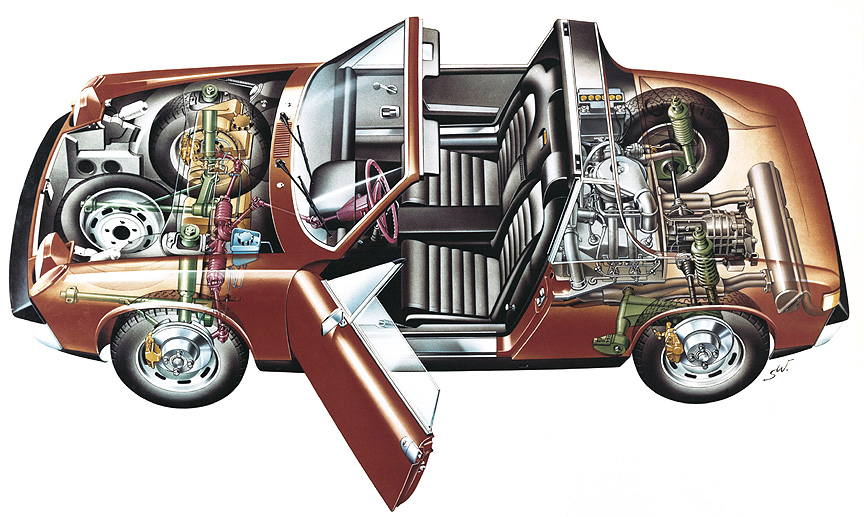
There was the second 3.0-litre prototype created as a surprise for the company leader Ferry Porsche for his 60th birthday. While the Piëch’s 914/8 had Bosch Kugefischer mechanical fuel injection, Ferry’s 914/8 was equipped with the carburetors. And it was a coupé and not a targa – it had a welded steel roof with the sunroof. The car also had the fuel filler flap on the front lid while with the production models you had to lift the front lid for refueling.
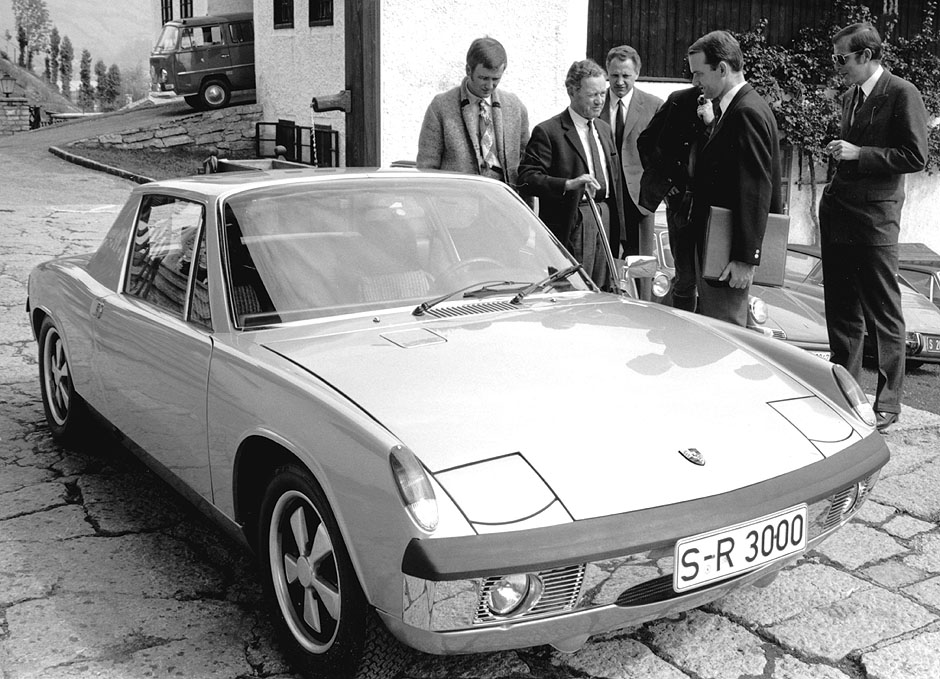
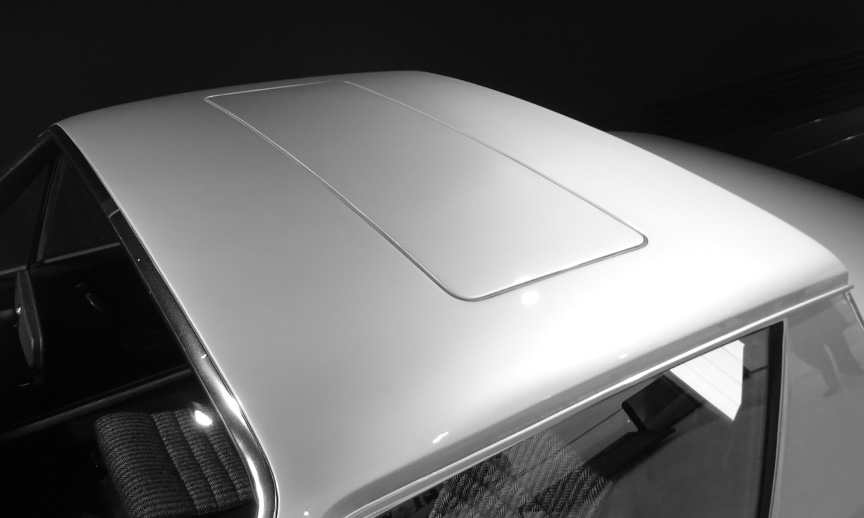
The 914/6 was produced with narrow body as street car and with wide body as competition car (commonly referred to as the 914/6 GT, although this is not the official name). The racing version was specified by the option code M491. It was possible to order the 914/6 street car with the wide body of the racing car. The option code for only the wide body was M471. It was a very expensive option as the widebody conversion would be handmade at Porsche, not at the Karmann factory where the narrow-bodied cars were completed on the production line. The widened body panels were also available as spare parts. The street 2.0F6 had 81 kW, but the competition version exactly double, 162 kW @7800 rpm (engine type 901/25, torque 20.5 mkp/148 lb-ft/201 Nm). Like on the street car, 2 triple Weber carburetors were used. Empty weight was 880 kg/1940 lb. Top speed depended on the gearbox ratios, but was at least 150 mph/240 kmh.
On June 14, 1970, Porsche finally won the Le Mans 24H race with the 917 and as a surprise the 6th position and 2-litre class victory was taken by a debuting 914!
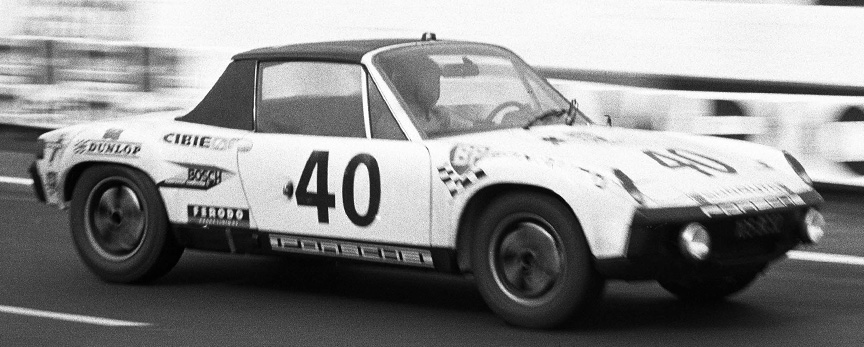
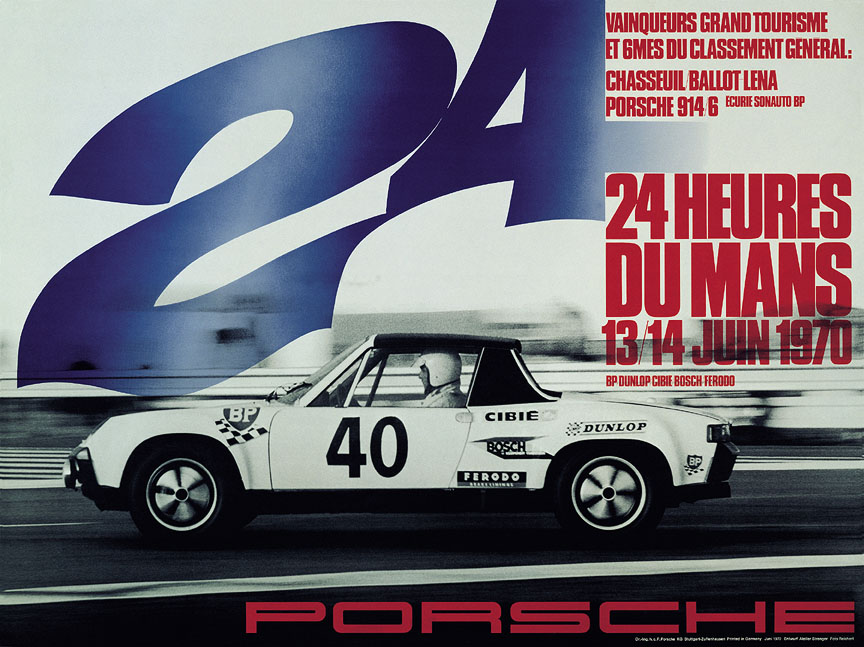
In 1970 in the USA, the 914 was voted the “Import Car of the Year”.
Four 914/6 racing cars were signed up for the 1970 Marathon de la Route 86 hour (!) endurance race held from August 18 to 22. It was held on the 28 km combined track of the Nürburgring Nordschleife and Südschleife. The first MDLR on the Nürburgring was held in 1965. In 1967 and 1968 the event was won with a 911. The rules said it is only allowed to spend 1 minute in the pits for driver change, tyre change or refuel. When more time is spent, a lap is deleted from the final results. Stopping in pits for more than 15 minutes – disqualification. If you would spend more than 24 minutes (30 minutes during first 4 hours) for one lap, you would be disqualified. During the last 12 hours as many laps has to be driven as during the first 12 hours. No doubt on how tough the event was! And it was just a year ago, in 1969, when the Police of Adenau wanted to stop the whole race because some cars had damaged or lost their exhaust systems and drove with very loud noise as stopping for repairs would be penalized.

The privately entered 914/6 of team Neusser MSC retired due to an accident, but all three 914/6 M491 entered by Porsche System Engineering finished and all on podium! The fourth place was taken by a BMW 2002 Ti and fifth place by a 911. In total 24 cars out of 64 starters finished. Great result considering the strict rules.
- #1 Gérard Larrousse, Helmut Marko, Claude Haldi, total 360 laps/358 laps counted
- #3 Björn Waldegaard, Åke Andersson, Guy Chasseuil, 359/357 laps
- #2 Claude Ballot-Léna, Günther Steckkönig, Nicolas Koob, 356/354 laps
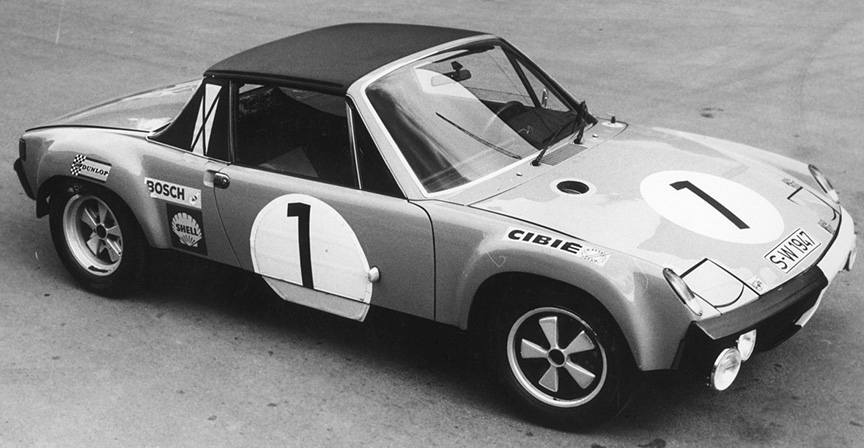
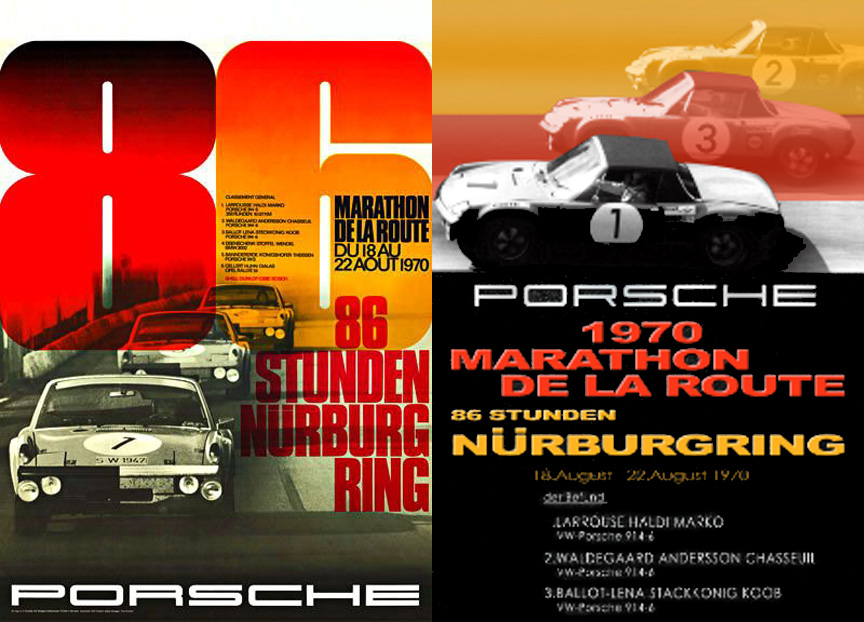
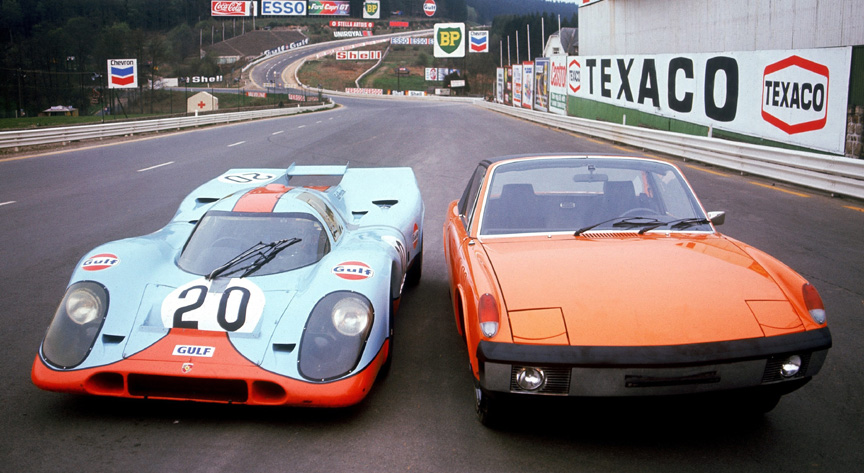
In 1971 the event was held for the last time – then on Nordschleife only and for 4 full days (96 hours). In 1971, for model year 1972, the proper passenger seat was announced and the dashboard was modified to have side air vents.
The 914/6 2.0 carburetor version was discontinued after the 1972 model year and the 914/4 2.0 EFI was introduced for MY1973. It produced a bit less power (74 kW), but the same amount of torque (16 mkp/115 lb-ft/157 Nm). In Japan and in the States the 2.0 4-cylinder was also called as the 914 S. 914/4 2.0 was capable of accelerating from 0 to 100 km/h in 10.5 seconds and to the top speed of 118 mph/190 km/h. Both the MY1973 4-cylinder cars, the 1.7L and the 2.0L, had empty weight of 950 kg/2094 lb (MY1970 1.7L was 900 kg/1984 lb). The standard compression ratio of the 1.7-litre engine was 8.2:1, but for California 7.3:1 which meant the engine lost 10% from its already ridiculous power figures. The 53 kW Californian version was made only for the 1973 model year.
In addition to M-option list, there were two option packages for 1973 European models. The Comfort-package included velour carpets, sports steering wheel, centre console with clock, oil temperature and voltmeter gauges, leather gear lever boot, safety bar covered with black vinyl, chrome trim on safety bar and two-tone horn. The Sports-package included forged 4-bolt Fuchs wheels, stabilizer bars front and rear and H4 halogen headlamps.
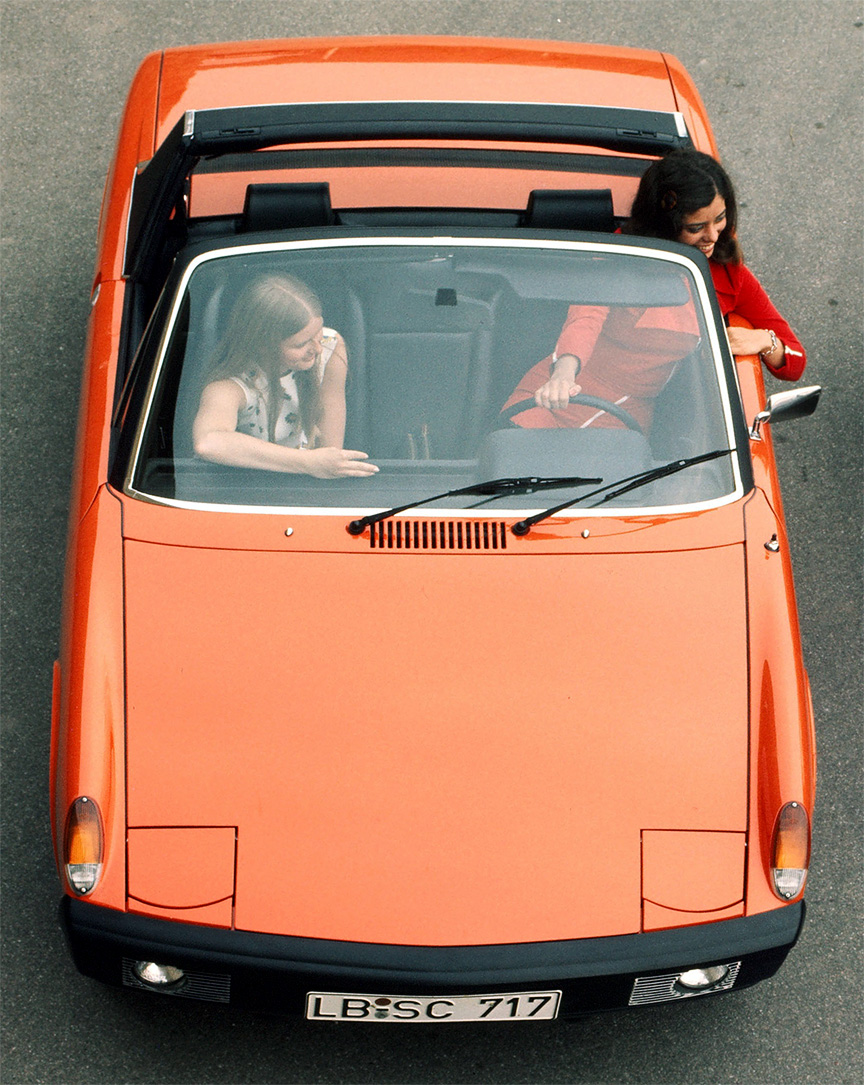
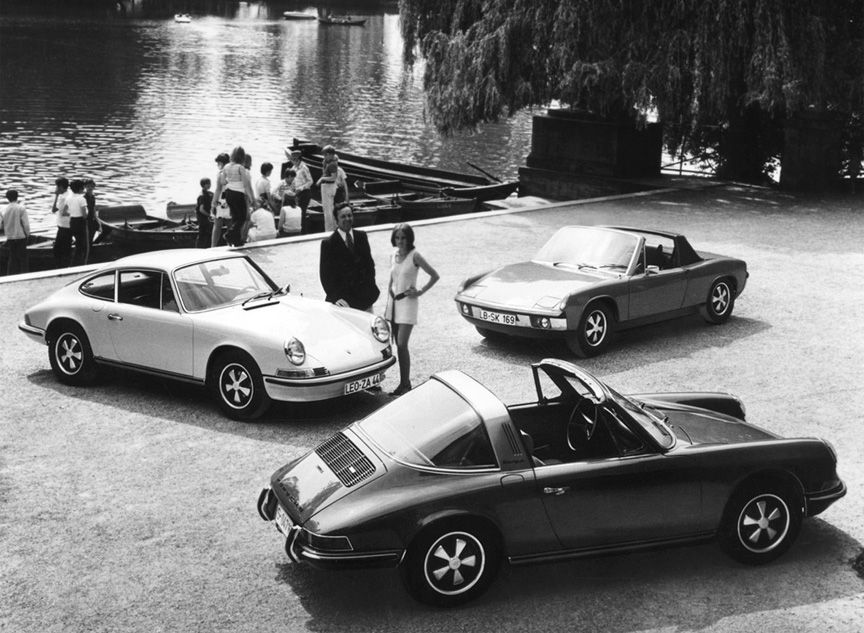
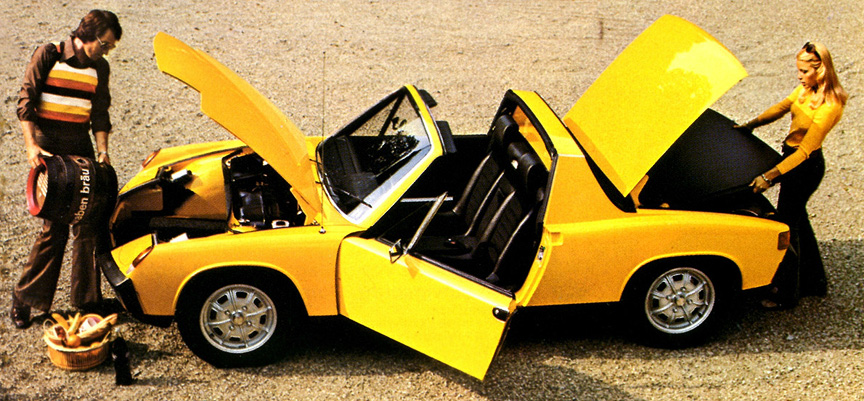
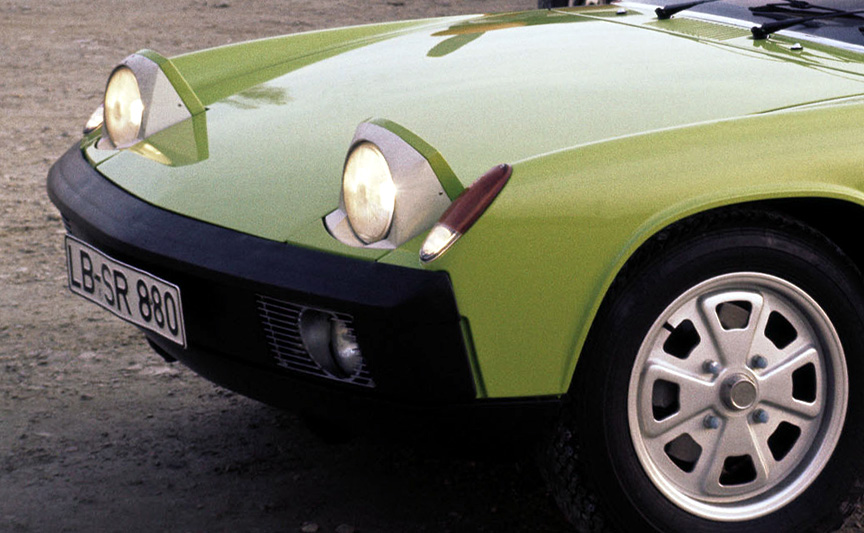
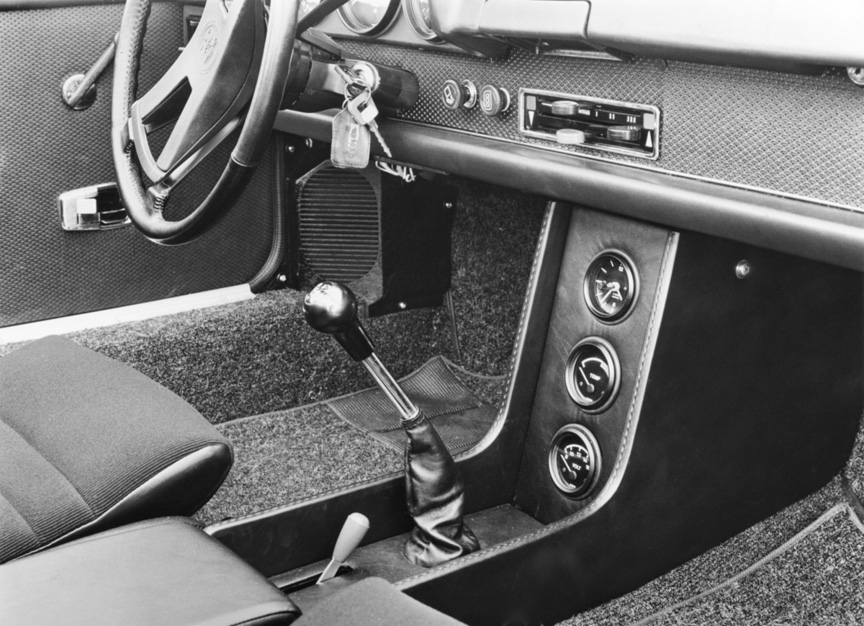
On July 28, 1973 a test run was organized at the Volkswagen’s Ehra-Lessien test track. The new MY1974 VW-Porsche 914 1.8 in the hands of Fritz Huschke von Hanstein achieved the following average speed results:
- Standing start 10 km – 108.203 mph / 174.136 km/h
- Standing start 10 miles – 112.215 mph / 180.592 km/h
In 1973, for the model year 1974, the base engines now where 1.8 litre. The news were not good for Americans – the US version lost a bit power compared to the outgoing 1.7-litre and the rear look was made hideous by the bumperettes (the front ones had appeared already a year earlier). For European market, the 1.8-litre was equipped with the carburetors (the only 4-cylinder 914 without fuel injection) and got bit more power than the predecessor. The ‘European’ 63 kW 1.8L 914 accelerated from 0 to 100 km/h in 12.5 seconds and to the top speed of 110 mph/178 km/h. It had 13.8 mkp of torque (99 lb-ft/135 Nm). Empty weight was 950 kg/1984 lb. From MY1974 came the automatic seatbelts and headlamp washer became available on the request of the Swedish market.
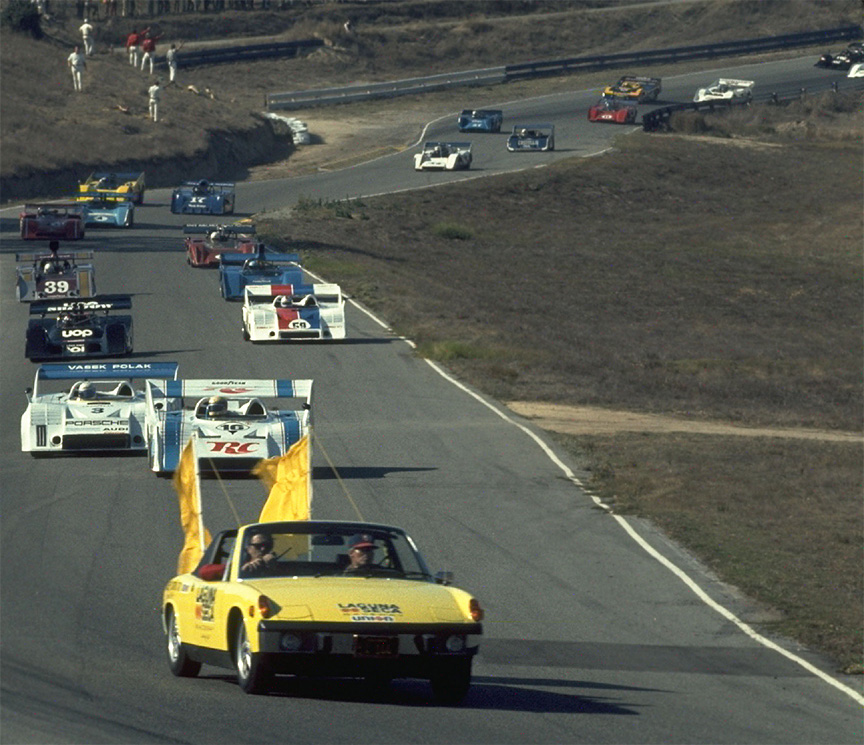
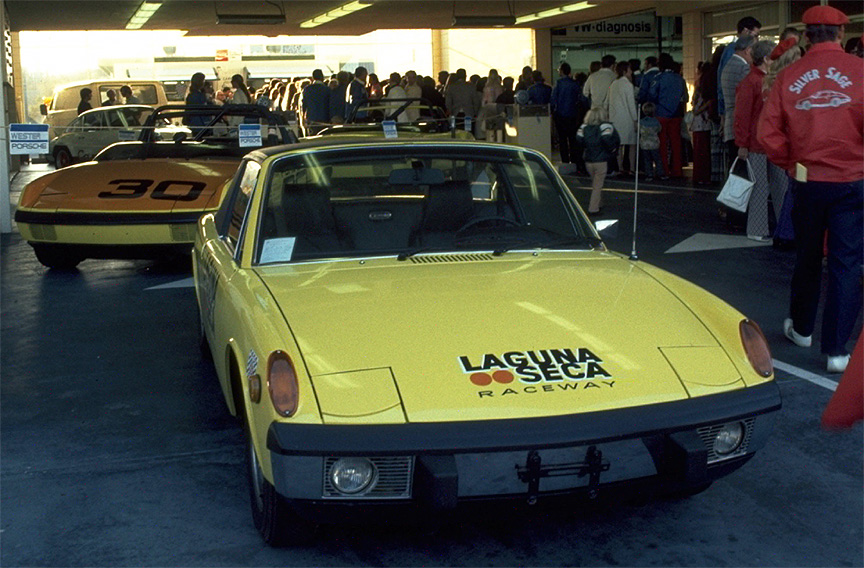
The 1974 914 models had the following jovial colors available: Light Ivory (the shade of white known from the ’73 911 Carrera RS), Bahia Red, Signal Orange, Chrome Yellow, Ravenna Green, Summer Yellow, Forest Green, Olympic Blue, Phoenix Red and special colours Black, Metallic Chrome Yellow, Metallic Ocean Blue, Silver Metallic and Metallic Marathon Blue. The interior was available in black, brown or beige.
In 1974, a limited edition 914 model was available either in black with yellow trim or in white with red trim. In the prototype stage it was called the “CanAm”-edition (and was seen with various CanAm side stickers), but then Porsche decided not to compete in the 1974 CanAm season due to rule changes and so the car was relased just as the ‘Limited Edition’. As the CanAm couldn’t be associated with this edition of the 914 anymore, it was now said to mark the 100.000th 914 built. In USA it was sold with the PORSCHE-side lettering, whereas that was not possible in Europe, because it was as much Volkswagen as it was Porsche. In Japan the Limited Edition was called the SL, ‘Sports Limited’. Although called the ‘Limited Edition’, in reality no records are available on how many cars were ordered in this trim – estimated at least 1000 cars.
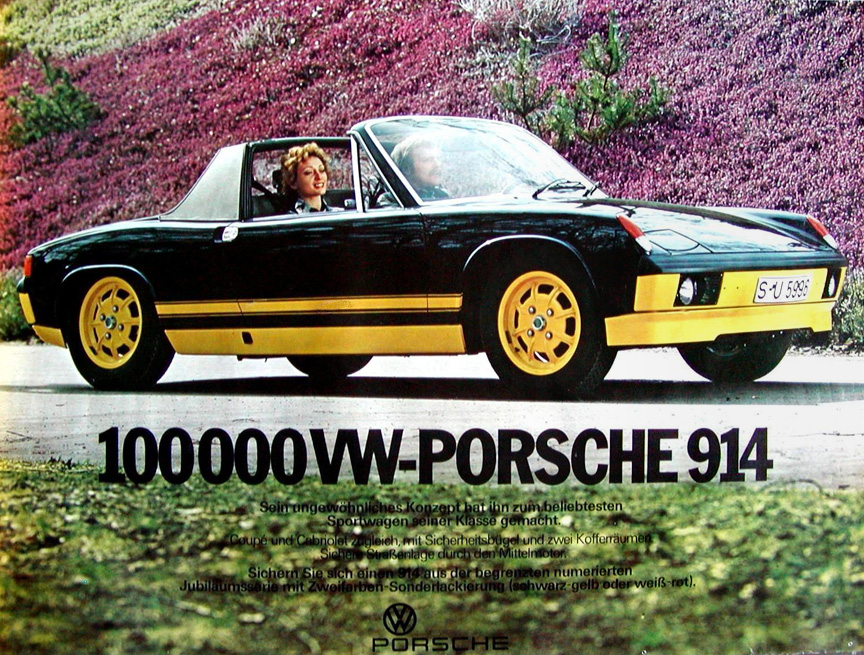
The ugly bumperettes on the US-models forced Porsche designers to come up with something new. In 1974, for model year 1975, the new design bumpers were introduced. This meant the European models were also equipped with the new heavy rubber bumpers.
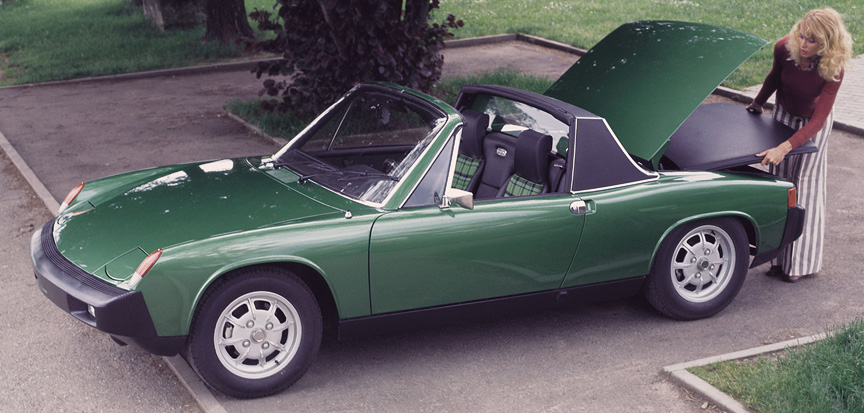
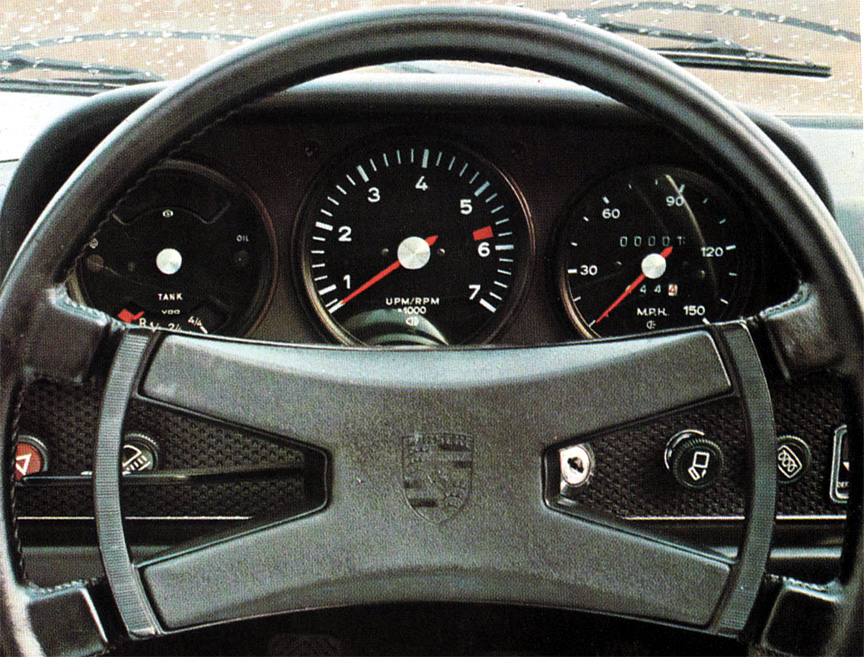
For 1975 model year, the catalytic converter was available. In addition to specifying individual options, two option packages were available. The Appearance Group included the fog lights, dual-tone horn, steering wheel and gear lever with leatherette cover, center console with clock, oil temperature gauge and voltage meter. The Performance Group included front spoiler, cast alloy wheels, front and rear stabilizer bars. The cars became heavier year by year and so the official performance data for the 1975 European models looked as follows:
- 1.8L: 0-62 mph/100 km/h in 13.5 seconds, top speed 107 mph/172 km/h
- 2.0L: 0-62 mph/100 km/h in 12.0 seconds, top speed 112 mph/180 km/h
(DIN dry weight 1000 kg / 2205 lb)
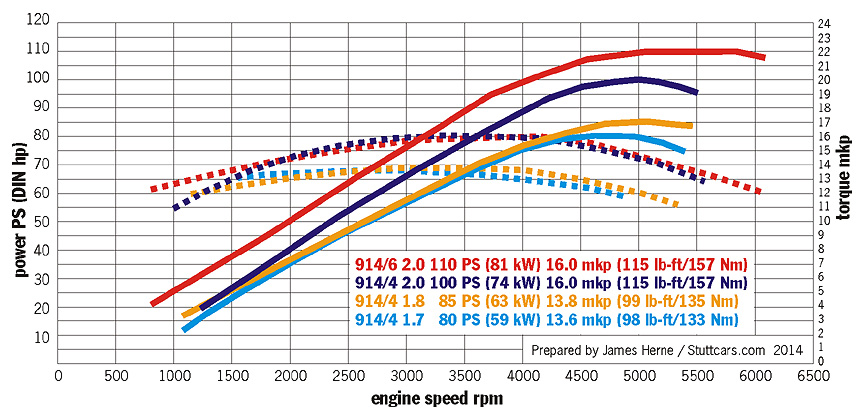
Many design companies chose the 914 as a base for their own one-off show cars, for example the Carrozzeria Eurostyle (Albrecht Goertz), Pietro Frua, ItalDesign (1970 Porsche Tapiro).
The 914 was produced only in left-hand-drive version. Initially it was expected that around 25% of the cars would get the Porsche engine, but in reality only 3% did. The production numbers were as follows: 914/4 counted for more than 115.000 and the 914/6 for less than 4000. The 914/4 had the Volkswagen chassis numbers (starting with 47…) and the 914/6 had the Porsche chassis numbers (beginning with 914…). The 914 was replaced by the 924.


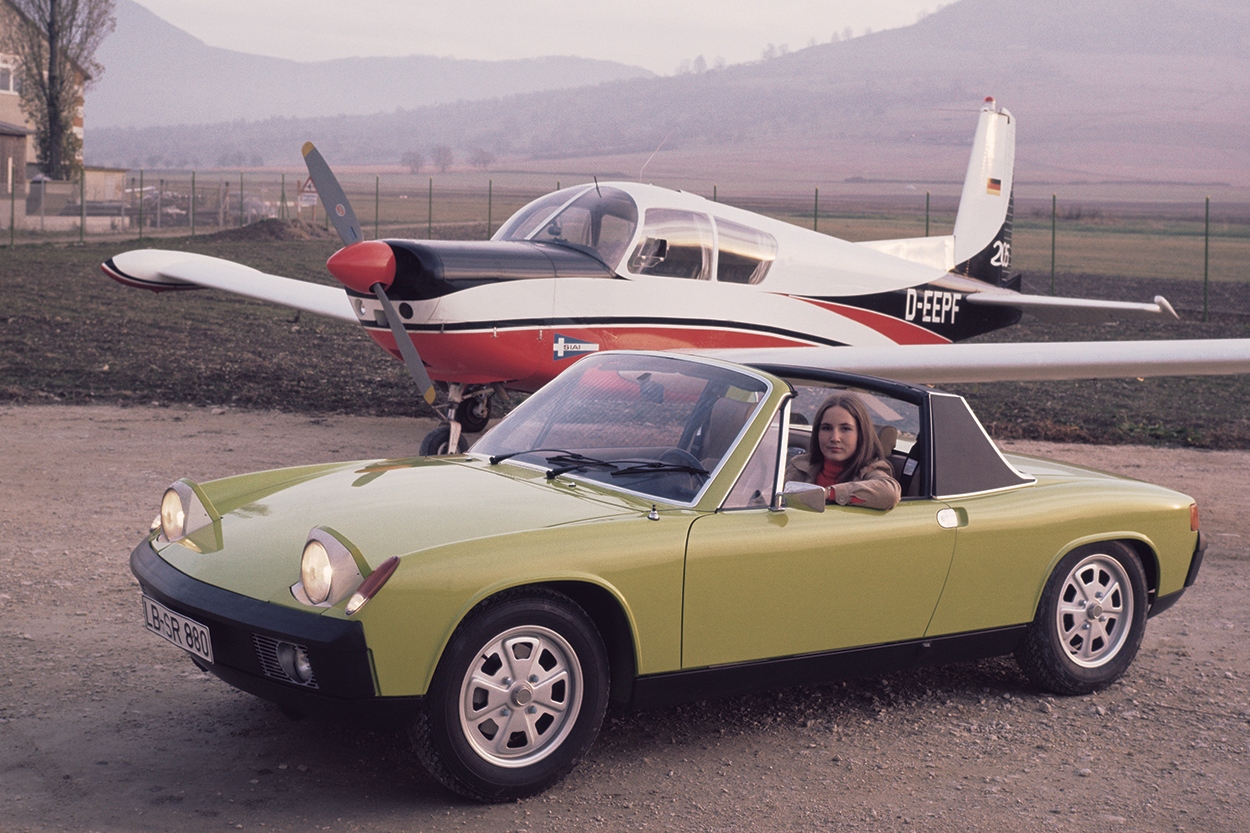
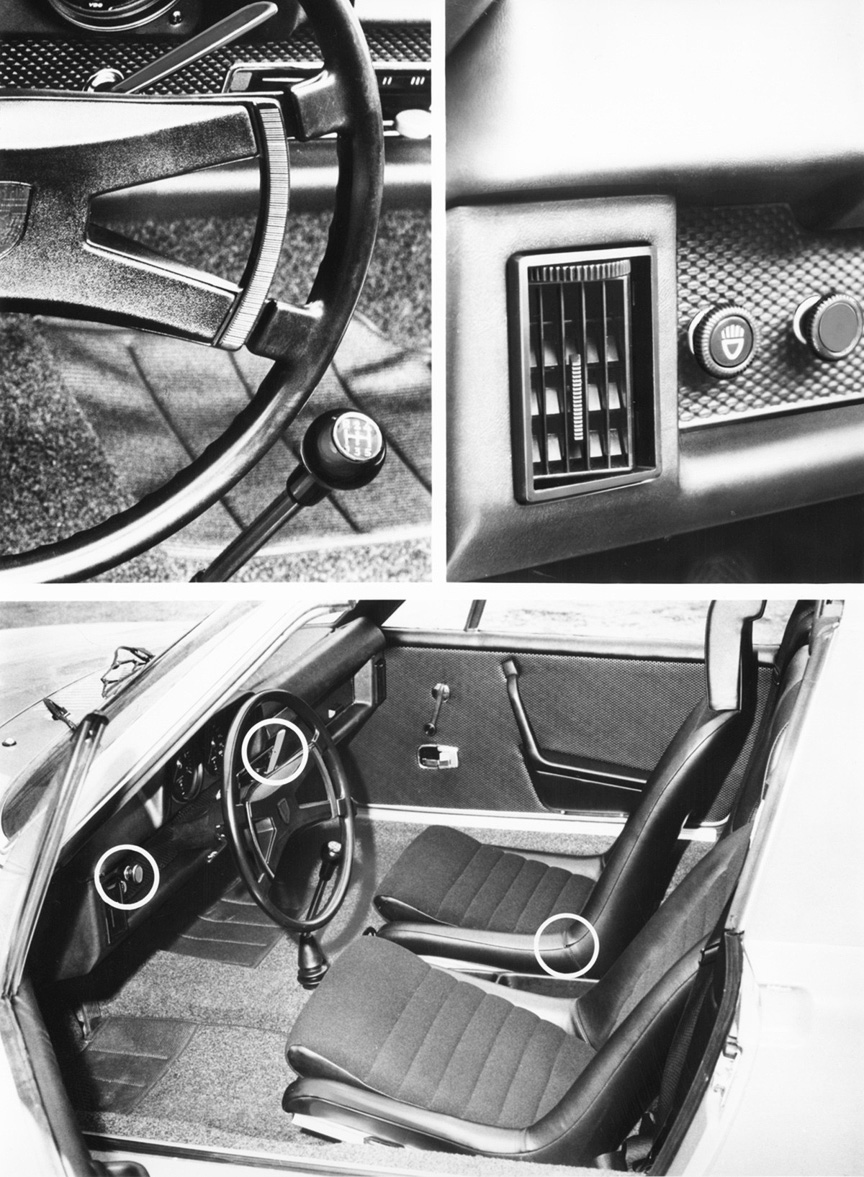

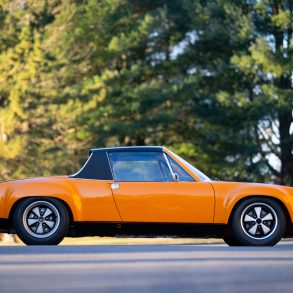
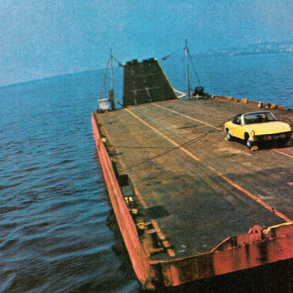
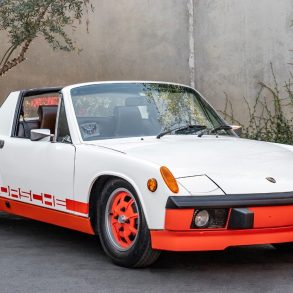
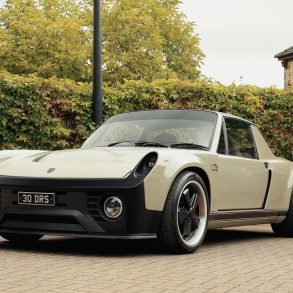
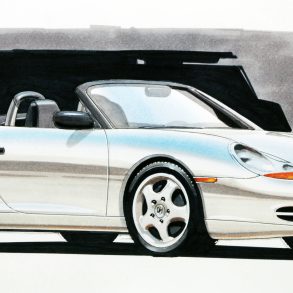
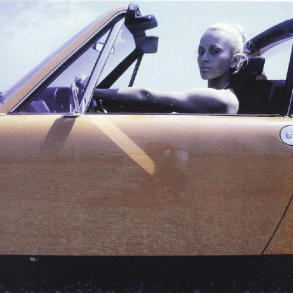
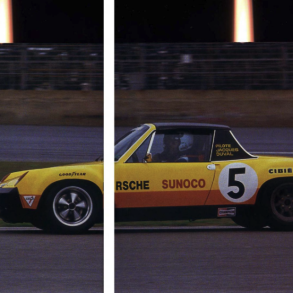

I really miss my 74’ – 6
0
Главные новости мира https://ua-vestnik.com и страны: политика, экономика, спорт, культура, технологии. Оперативная информация, аналитика и эксклюзивные материалы для тех, кто следит за событиями в реальном времени.
0